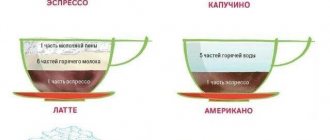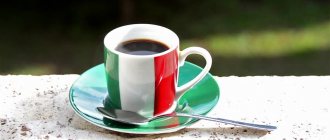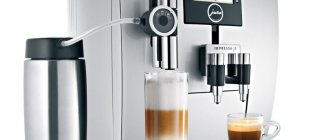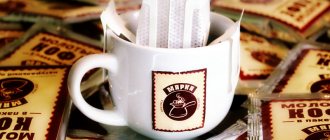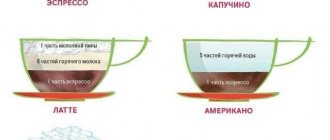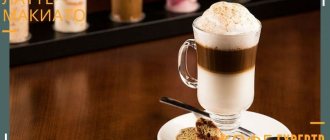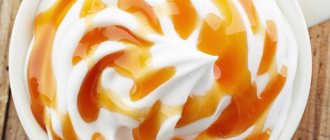Latte is a popular drink that is on the menu of every coffee shop. Many people like the bright, unique aroma and combination of taste of fresh natural milk and coffee. It is served in glasses, decorated with whipped foam, grated chocolate and nut crumbs. There are several types of latte glassware.
What is the correct name for a latte glass?
A specific name is not given, since even the origin of the drink is not entirely accurate. Moreover, various types of containers are used for serving coffee:
- glasses;
- glasses;
- mugs;
- cups.
Fans of coffee cocktails love lattes for their large volume, low strength, soft creamy taste and the opportunity to experiment with toppings.
Each of them allows the barista’s imagination to run wild and surprise the client with something unusual.
There are several types of dishes to serve this drink - a cup, a glass and a latte glass.
Why do you need a DeLonghi glass?
DeLonghi glasses are distinguished by the presence of double glass, so even drinking fairly hot espresso will not cause discomfort. We're not talking about latte at all.
Luxurious, spacious and branded - that's what they are all about.
The glass can also accommodate double espresso; larger models are rarely found.
Espresso glasses are commonly referred to as double-walled glass containers.
Why are lattes served in special glasses?
Unfortunately, there are too many inaccuracies to answer the question about the origin of serving this coffee drink. The name deserves special attention - “Latte” - in Italy this was the name for milk served in tall glass glasses. Coffee itself is now served in the same way. Further, according to the history of the drink, they began to add a portion of espresso to the latte milk (instead of topping), and this is how this type of coffee turned out. However, in its homeland it is called latte macchiato or coffee milk translated into Russian.
As with many coffee stories and recipes, the origins and presentation of the latte have many inaccuracies.
Foam appeared even later - with the advent of cappuccino makers. Initially there was none.
Latte is Italian for milk, served in tall glass glasses.
Additional information: baristas quickly noticed that when pouring coffee into milk after whipping the foam, the latter remained under it. Thanks to this, the drink acquired the form known to all of us.
As an experiment, Italian bartenders began adding a shot of espresso coffee to milk as a topping.
Today, latte macchiato glasses are a pleasant continuation of the traditions of the past. Preference is given to clearly distinguishable layers - aesthetically it looks much more beautiful, especially if the drink is additionally sprinkled with chocolate chips or cinnamon.
Baristas noted that if a shot of espresso is poured into milk in a special way immediately after whipping, the coffee gets under the light and loose foam, forming a dark layer.
Main characteristics of latte glasses
Glasses, glasses, cups and mugs have approximately the same volume:
- first: from 150 to 300 milliliters;
- second: from 250 to 300 milliliters;
- third: from 250 to 320 milliliters;
- fourth: from 300 to 360 milliliters.
The tradition of serving lattes in glass glasses has continued.
Glasses differ from others not only in their practically fixed volume, but also in the absence of a handle. In this regard, it becomes important to serve the drink at a certain temperature so that the person drinking it does not burn his hand.
To this day, many establishments continue to prepare lattes so that the layers of the drink are clearly visible.
The design varies. It all depends on the barista’s imagination.
Today, the choice of containers for latte is very large.
Types of tableware for latte coffee
Thanks to the human desire to stand out, not only different serving methods, but also types of containers began to be used for the drink. Each of them opens up new scope to surprise the client.
Over time, other interesting serving options for this recipe have appeared.
Drawing, topping, topping, natural berries - these are just the bare minimum of design elements for this coffee.
The choice of glassware for drinking it depends on the type of drink and your preferences.
Latte glass
One of the classic options most often found in establishments. The volume depends on the personal wishes of the client or is set in the menu. From 150 to 300 milliliters (standard).
Made of glass, has a volume from 150 to 300 ml, equipped with a handle.
There are two types of glasses:
- With a middle leg. The bowl expands from bottom to top. Has a smaller volume.
- With a short leg. Standard size for 300 ml containers. There is a pen.
There are two main types. On a short stem, similar to an enlarged glass and a regular one, reminiscent of a glass cup.
All coffee glasses are transparent. The drinker should see smooth transitions from milky white to coffee brown and back.
Latte glass
The main difference from the previous type of container is the absence of a handle. Volume 250-300 milliliters. Often served on a saucer.
It is distinguished by the absence of a handle. Its volume ranges from 250 to 300 ml.
Latte cup
A cup is a separate type of tableware. Laconic inverted trapezoid shape, comfortable handle. Opaque. Preference for cup colors is white, cream and vanilla.
Most often it has the classic colors of coffee utensils - white, cream, vanilla.
Often sold complete with a small saucer and small spoon. Volume up to 320 milliliters, larger specimens are rarely found.
Latte mug
Thick-walled porcelain or ceramics are the main materials used in the manufacture of mugs. Quite heavy, somewhat rough for a delicate drink, which partly complements it.
Latte mugs can be straight-sided or tapered at the bottom.
It is distinguished by increased reliability and some comfort created by peace of mind.
They do not pretend to be graceful; they are often decorated with cute designs or various ornaments.
It’s difficult to call mugs elegant, but cute designs and various ornaments more than compensate for this. Volume up to 360 milliliters.
Story
The traditional glass version of the latte glass began to be used relatively recently – at the beginning of the 21st century. This added aesthetics to the presentation and attracted customers, because they like to place interesting orders in order to be the center of attention. The curious looks made it worth the drink's slightly higher price compared to most varieties.
The traditional glass version of the latte glass began to be used relatively recently – at the beginning of the 21st century.
When, by whom and under what circumstances was the glass invented?
It is believed that the idea for the latte recipe originated in small towns in Italy wanting to attract tourists. The Italians themselves drink black coffee (coffee), but they have a word “latte”, meaning “milk” or exclusively “milk drink”. They came up with the idea of adding a coffee drink or hot chocolate there. The guests liked the recipe, and they began to “export” the idea abroad.
The Italians themselves called their invention “latte macchiato”. However, only the first word reached Europeans and other people. It was fixed in history under such a name, familiar to our contemporaries.
It is believed that the idea for the latte recipe originated in small towns in Italy wanting to attract tourists.
Types of glasses
Now this coffee drink is served in all cafes and restaurants, but it can be poured into different containers, this is variable:
- Traditional transparent glasses for latte coffee with a volume of 150-300 ml. Large options often have the shape of an elongated glass, but dishes with a short stem hold less drink. But in any case there must be a handle.
Traditional transparent glasses for latte coffee with a volume of 150-300 ml. - The latte glass has no special differences from the previous glass, only it does not have a handle, and the volume is 250-300 ml.
The latte glass does not have a handle, and the volume is 250-300 ml. - The cup for this drink is made of porcelain or ceramic material. Its shape resembles the usual form factor of latte macchiato glasses, only upside down, but it remains elegant and laconic, pleasing to the eye.
The cup for this drink is made of porcelain or ceramic material. - The mug for this coffee drink is usually made of porcelain, less often ceramic. It is distinguished by thick walls and heaviness of the product compared to other options. But they are especially reliable and decorated with cute, pleasant images.
The mug is distinguished by its thick walls and heaviness of the product, compared to other options.
The choice of the type of glassware for latte is a matter of taste, but often cafe employees themselves prefer to choose transparent Delonghi glasses - products of a well-known company (they are small in size, do not have a handle, but have a very elegant shape), as they look impressive, which increases sales. Traditional utensils for this coffee drink are also popular, and in expensive restaurants the guest can be offered a choice of utensils.
The glasses are small in size, do not have a handle, but have a very elegant shape.
Why do they have this shape and volume?
The tall shape of latte glasses is designed to showcase the contrast between the different layers of the drink. A narrowed bottom with a circle expanding at the top adds sophistication, and no additional design is required; the dishes already look impressive. Aristocratic shapes, often with curves or light spraying using a gradient technique. They are becoming the choice of people who prefer classics and sophistication in their lifestyle; they are often characterized by the desire to look good and be remembered, to attract attention.
But if a person prefers not Delongi glasses, but cups or mugs with pleasant images, he strives for comfort more than creating an external image. It can also characterize the guest as progressive and modern, not burdened by the obligations of traditions and rules. This usually applies to representatives of the new generation.
But the volume of the glassware matters, because when preparing a coffee drink there is a specific recipe, which states that the height of the milk foam should reach 4-6 cm. A very small volume of a glass of Delonga for a latte or its other variety will not allow you to make a full-fledged coffee, since you will have to sacrifice rules or proportion.
The tall shape of latte glasses is designed to showcase the contrast between the different layers of the drink.
What material is it made from?
In this case, the glass should be made of natural material, without a specific smell. If it is plastic, then it is food grade for reusable use. Although the most popular materials are:
- Glass, often quite thick;
- Ceramics;
- Porcelain;
- Sometimes special plastic.
You should make sure of the quality of the material by reading the product documents, and it is also advisable to read the reviews.
If there is a need to buy such utensils in bulk, then you should first buy one unit and try to make coffee in it and take care of it. If these parameters are satisfactory, you can purchase the remaining part.
The material of the glass should be made of natural material, without a specific odor.
How to choose latte glassware
The correct choice of glassware for drinking a particular drink is of certain importance. So, giving preference to a glass, mug or cup, you should understand the following:
- they have different characteristics;
- has its own characteristics;
- different taste of the drink.
Today, transparent dishes are gradually being replaced by tall cups and mugs.
Most rely on aesthetic pleasure. After all, drinking a coffee drink is much more pleasant, at least from a mug with the inscription “Coffee”.
The real taste of latte macchiato is revealed only when the drink is smooth.
It is important to know: even in professional establishments, transparent containers are gradually fading into the background; tall cups and mugs are becoming more and more common.
Why? Everything is extremely simple!
- The revelation of real, full taste and aroma is possible when the drink reaches a homogeneous mass. The barista should pour the espresso in such a way that the mixing is maximum.
Glass is inferior to opaque materials due to the immediate loss of aesthetic appearance.
- Porcelain retains the original temperature of the drink much longer, which is important for establishments. Therefore, preference is increasingly given to thick-walled cups and mugs.
- The versatility of ceramic mugs. Suitable for tea, Americano, latte and other drinks.
A good barista will try to pour the espresso into the frothed milk to ensure maximum mixing of the ingredients.
Thus, transparent coffee glasses are gradually beginning to lose their former popularity. Establishments want to optimize costs, customers of coffee shops and cafes want to get maximum pleasure from drinking a coffee drink.
At the barista championship, lattes are evaluated, among other things, by the uniformity of taste. The layered structure is considered bad form for connoisseurs.
How to care
Before use, be sure to first read the instructions for use and care. After all, the material and shape features often require special handling, but usually maintenance is relatively simple:
- Timely cleaning of dishes with an appropriate detergent, either manually or in a washing machine. But if the instructions prohibit the use of very high liquid temperatures, you should not take risks with the dishwasher, since it is usually set to hot processing mode.
- Refusal from abrasives of any kind; in case of severe contamination, it is permissible to rub with baking soda, without zeal. Other types of abrasive substances in chemicals or in the form of a metal sponge or hard rag should be excluded. Otherwise, microscratches will appear that can ruin the appearance of the product and make it visually shabby.
- Do not use chemicals with a strong odor; it affects the aroma of the drink in the glass, and the coffee acquires an unpleasant specific taste. And this is fraught with dissatisfaction of the client or spoiled the mood of the coffee lover.
Timely cleaning of dishes with an appropriate detergent, either manually or in a washing machine.
So, latte dishes have many varieties in shape, color, material and volume. But usually tall transparent types are used to demonstrate the layering of ingredients of different shades, although this affects the taste. So when choosing such utensils, you should decide what is your priority: preparing tasty, smooth, rich coffee or a drink served in layers in a beautiful container.
